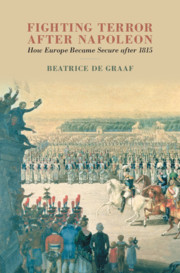Book contents
- Fighting Terror after Napoleon
- Fighting Terror after Napoleon
- Copyright page
- Contents
- Figures
- Maps
- Tables
- Acknowledgements
- Prologue
- 1 Introduction
- 2 Providence in Paris
- 3 Balancing in a Climate of Distress
- 4 ‘A Moderate Occupation’
- 5 Fausses nouvelles and ‘Blacklists’
- 6 Fighting terroristes Together
- 7 The Price of Security
- 8 Fortress Europe
- 9 Beyond Europe
- 10 Conclusion
- Bibliography
- Index
Prologue
Published online by Cambridge University Press: 12 September 2020
- Fighting Terror after Napoleon
- Fighting Terror after Napoleon
- Copyright page
- Contents
- Figures
- Maps
- Tables
- Acknowledgements
- Prologue
- 1 Introduction
- 2 Providence in Paris
- 3 Balancing in a Climate of Distress
- 4 ‘A Moderate Occupation’
- 5 Fausses nouvelles and ‘Blacklists’
- 6 Fighting terroristes Together
- 7 The Price of Security
- 8 Fortress Europe
- 9 Beyond Europe
- 10 Conclusion
- Bibliography
- Index
Summary
Though seemingly intangible, a continent’s degree of security can be measured by the anxieties of a lone traveller wandering its roads. It all begins with the question of whether the roads are safe. Are they passable, maintained and marked well? Much of the European Union’s progress towards an ever closer union runs along interlinked road works, the growing availability of Italian coffee in roadside cafes and the increasingly standardized fares for gas station toilets. The number of toll gates may be on the rise again, but highway robbers have rarely been sighted in the last few decades. This process of an increasing European integration of safety and security on the roads has had its precursors in previous eras.
- Type
- Chapter
- Information
- Fighting Terror after NapoleonHow Europe Became Secure after 1815, pp. 1 - 7Publisher: Cambridge University PressPrint publication year: 2020

